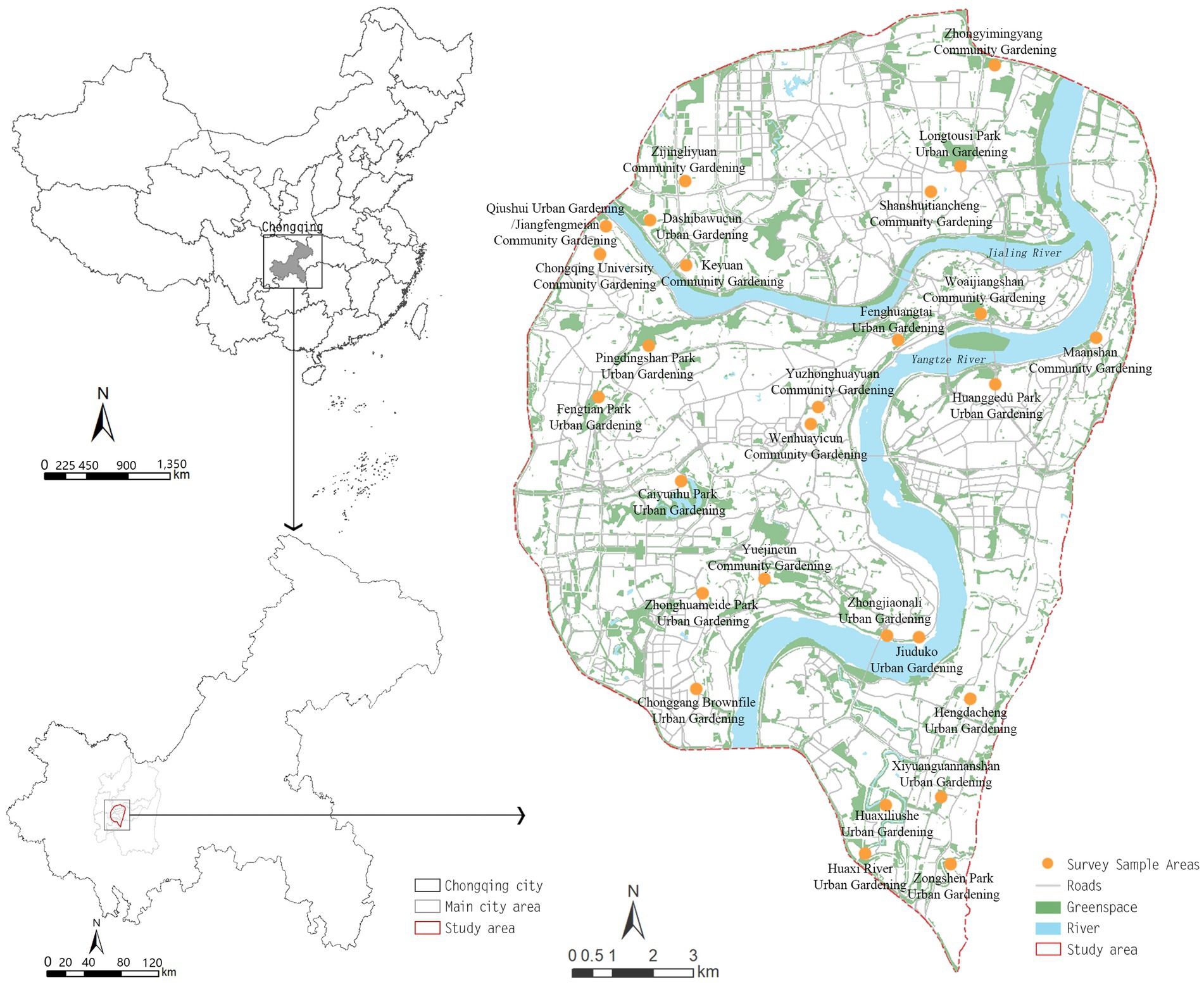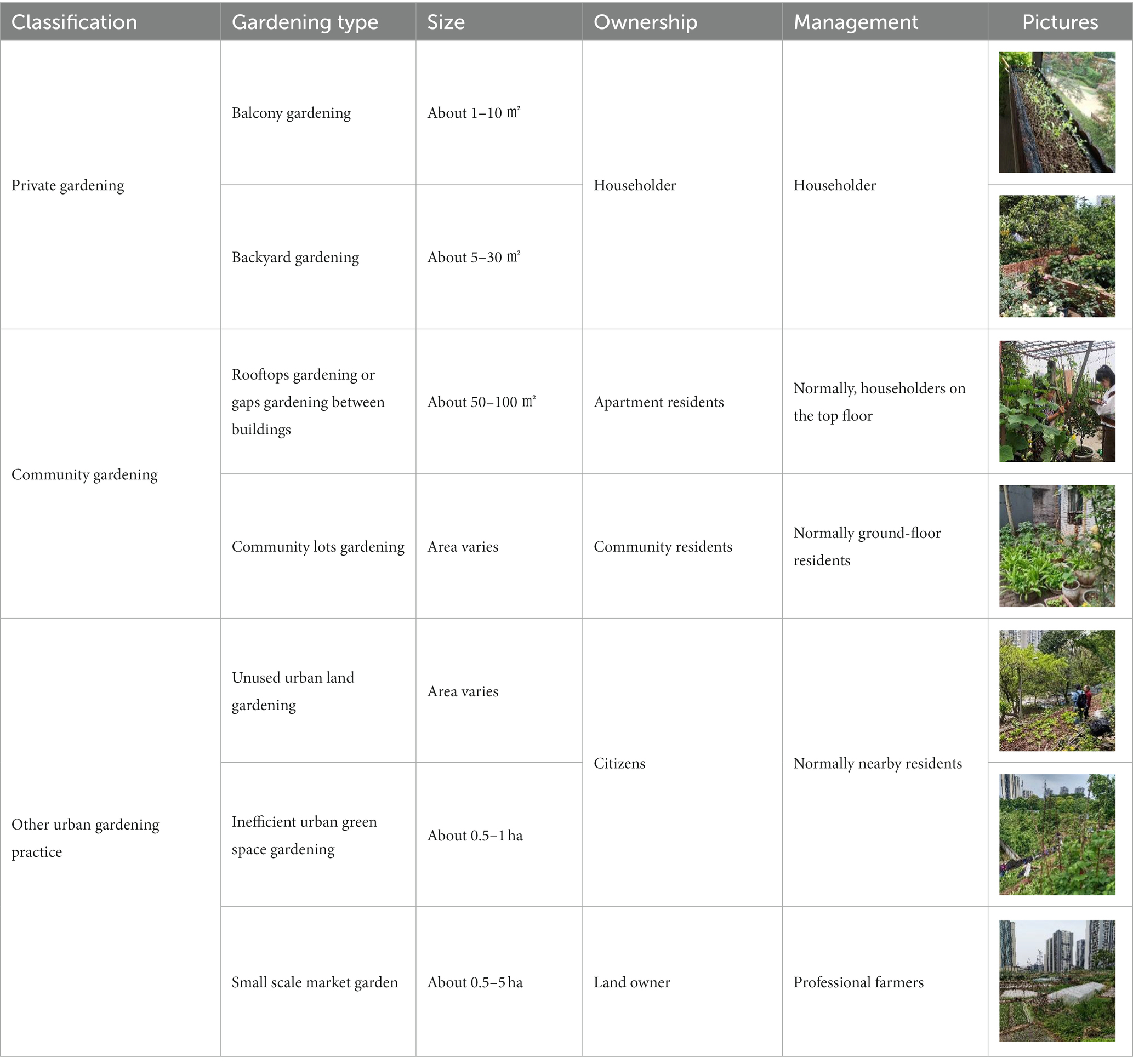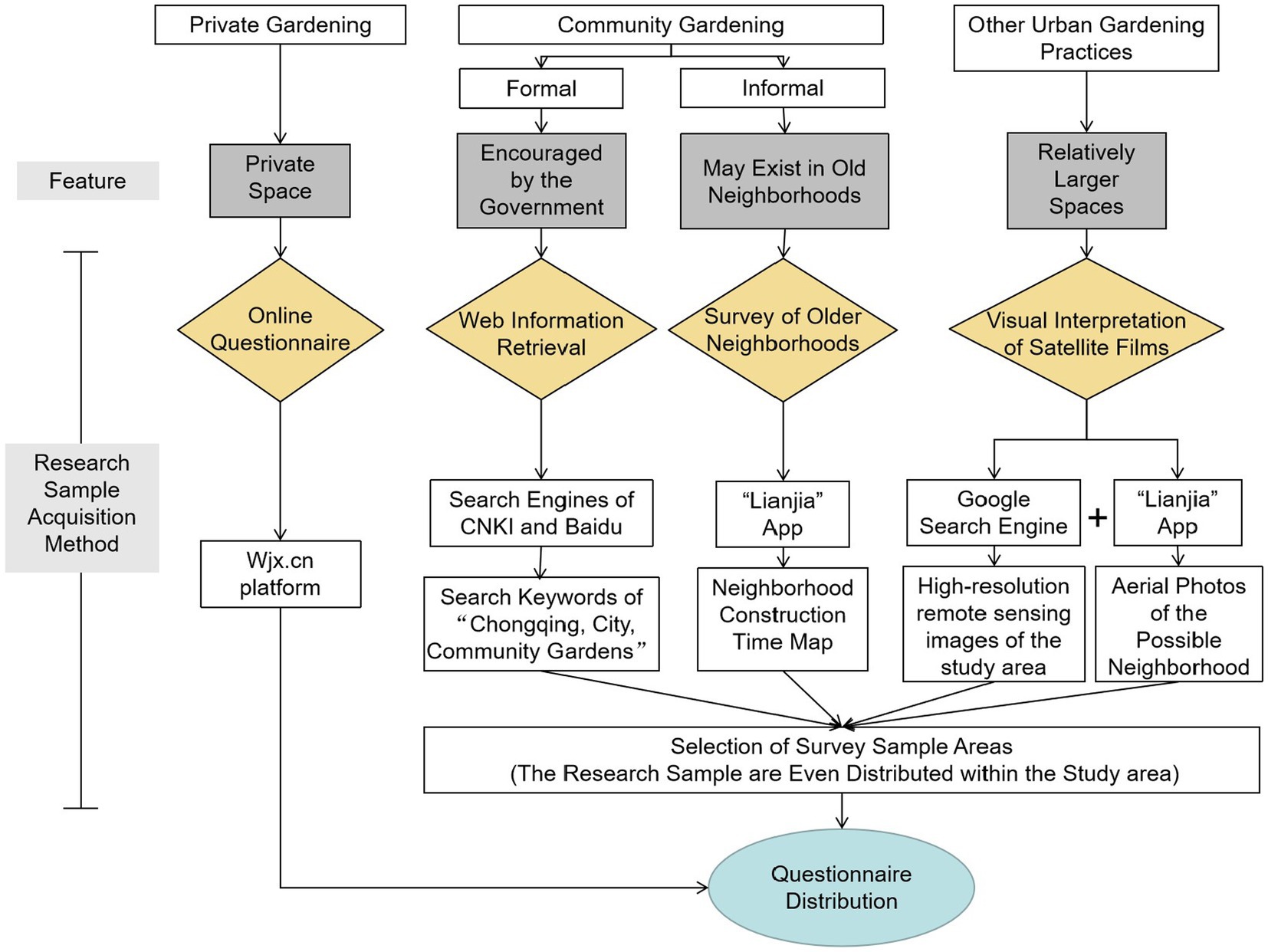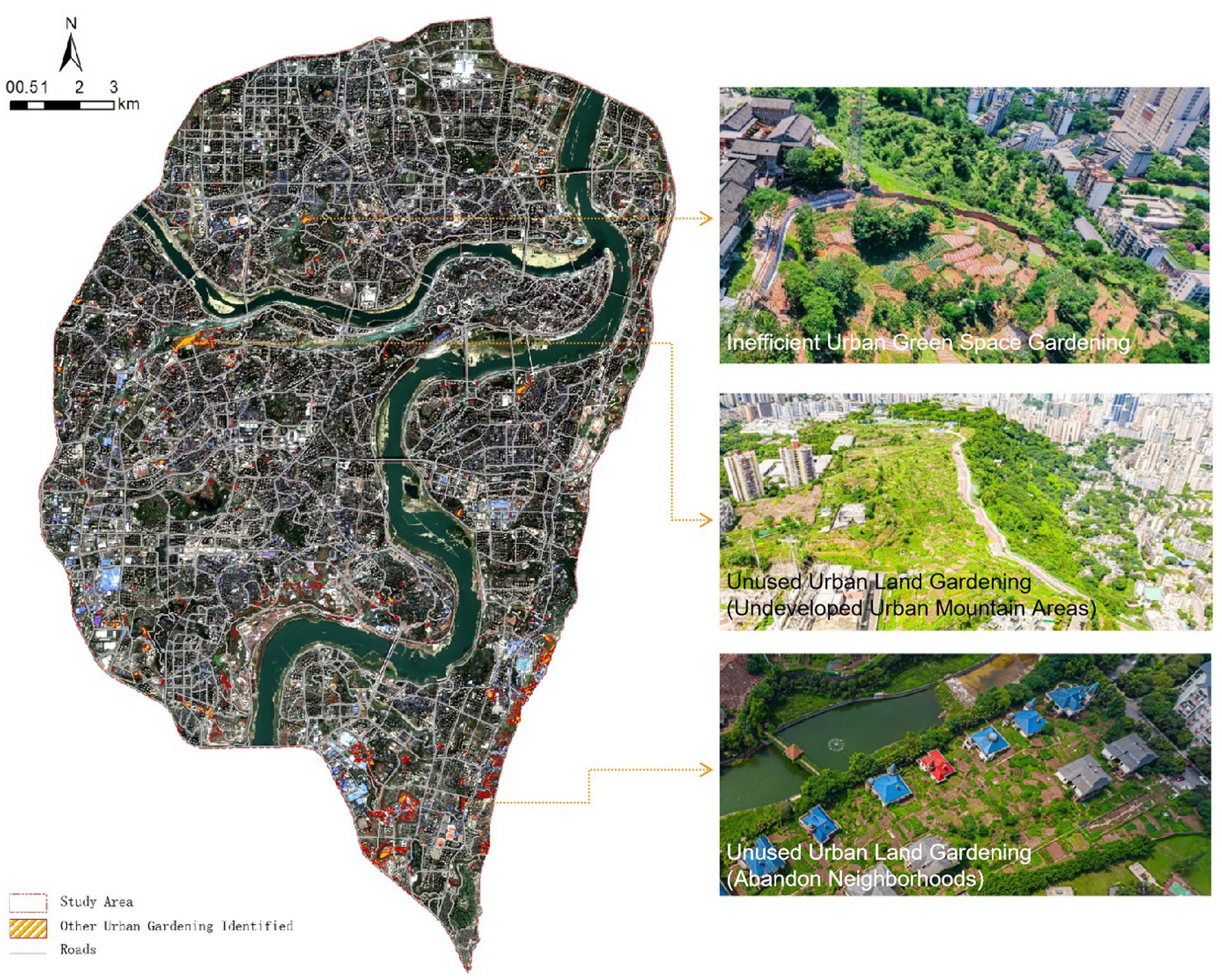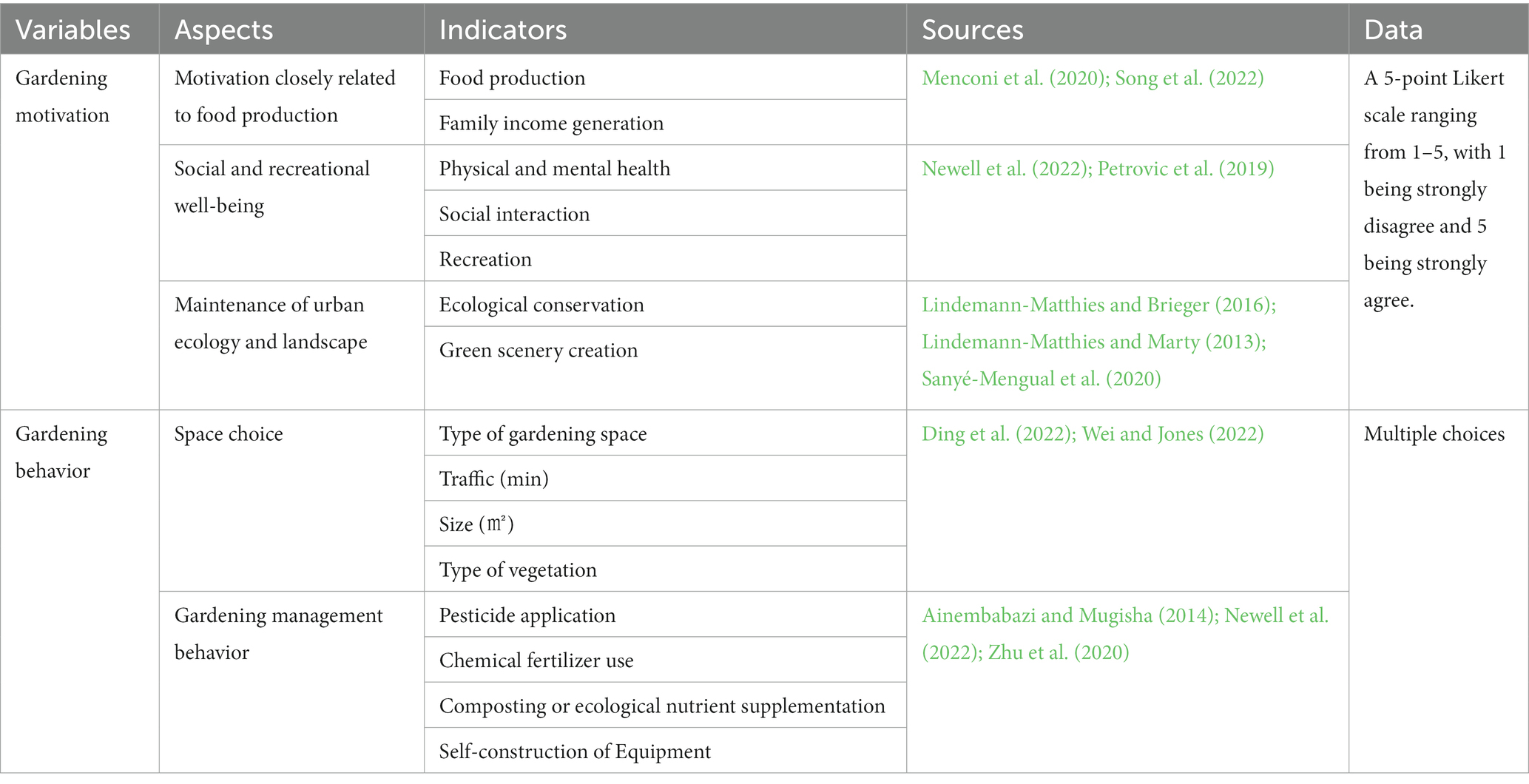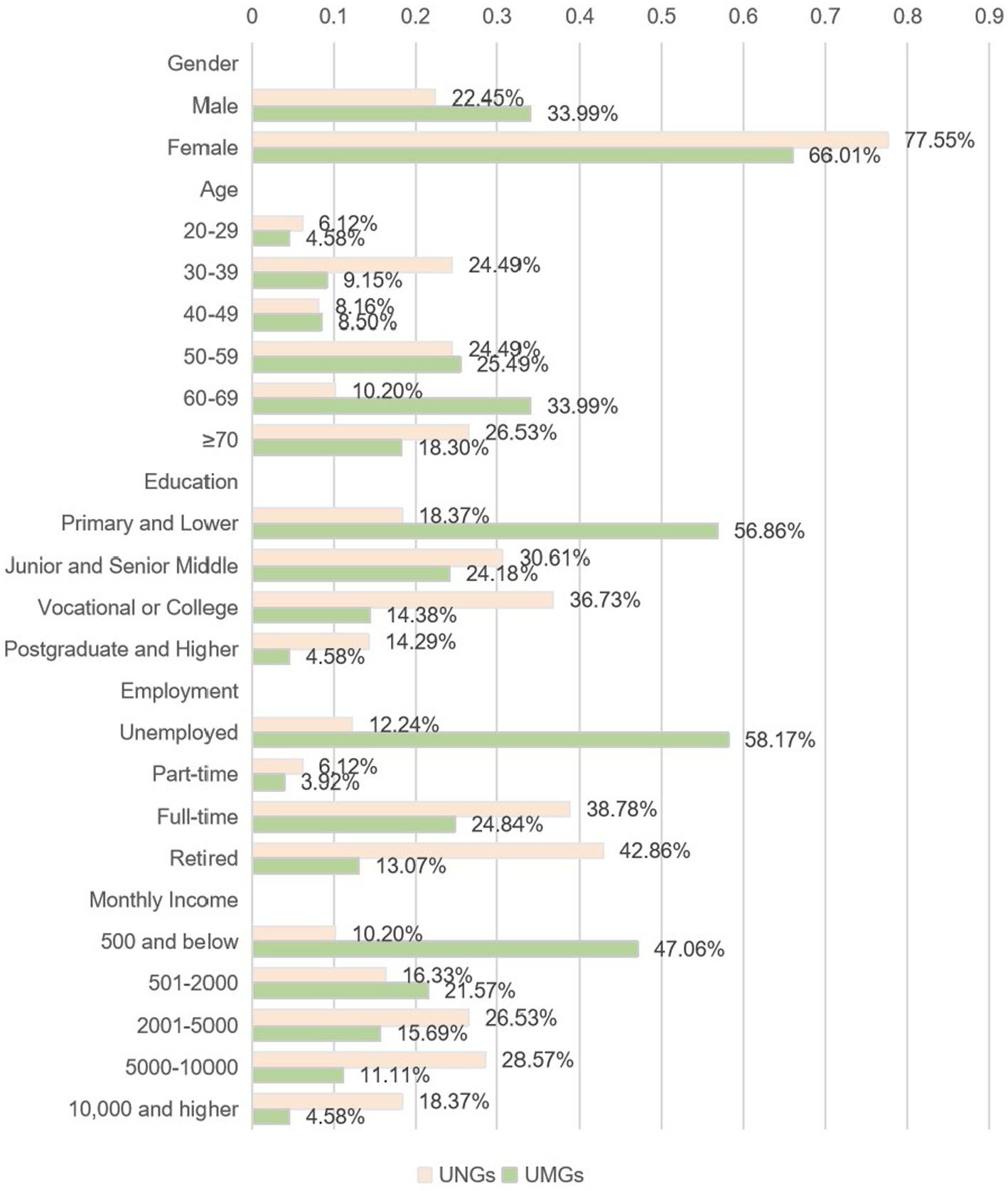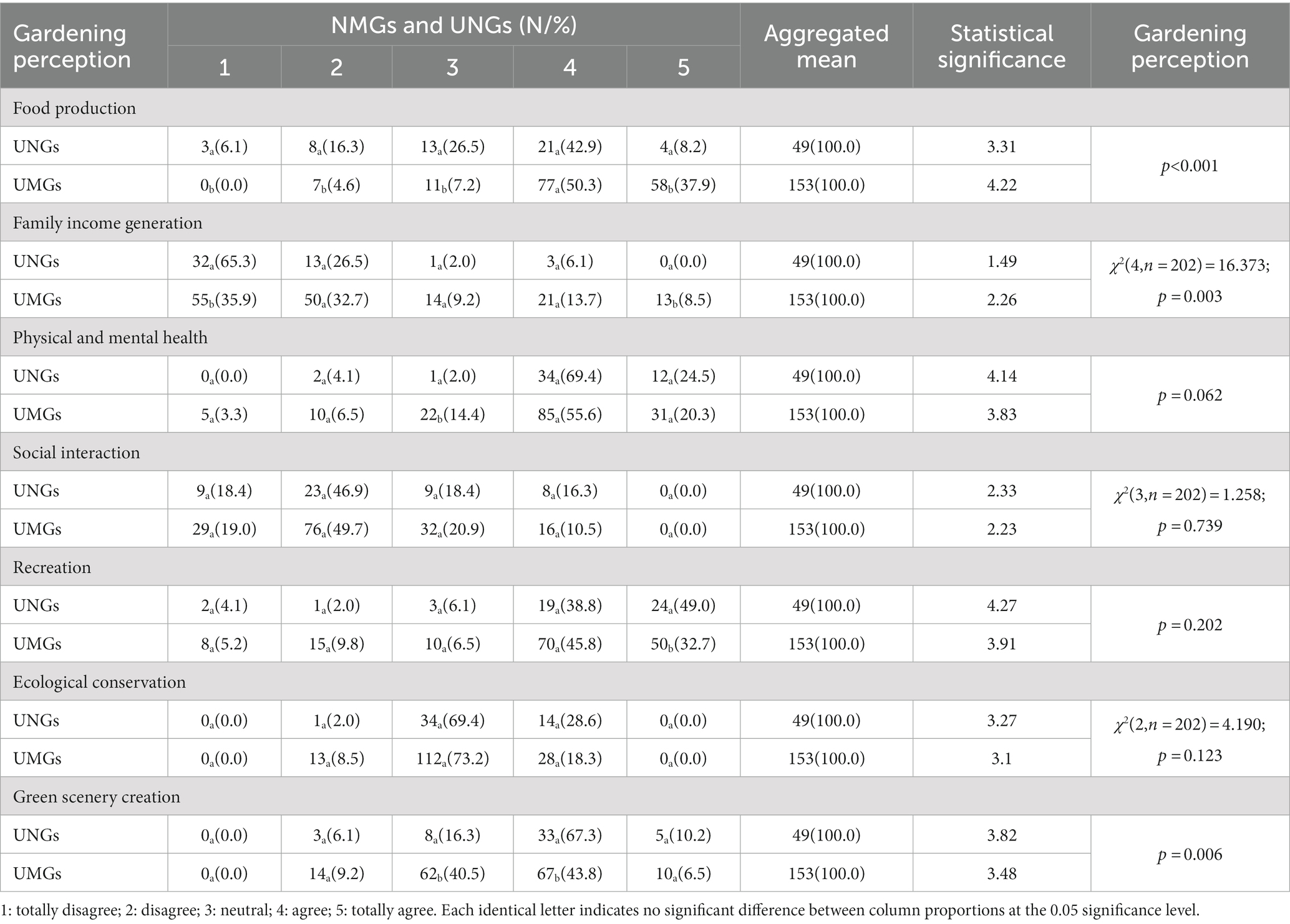Adapting to urban gardening in China: how will policymaking help migrant and native gardeners?
- Key Laboratory of New Technology for Construction of Cities in Mountain Area of Education Ministry, School of Architecture and Urban Planning, Chongqing University, Chongqing, China
China’s current urban gardening promotion policies mainly focus on community gardens and lack in-depth research on the differentiated needs of different urban gardeners. To meet the diverse needs of China’s gardeners, this study proposes a typology that classifies gardeners into urban native and migrant ones based on their urban and rural living experiences in China. A questionnaire survey conducted in the core area of Chongqing city revealed significant differences and some similarities in gardening motivations and behaviors between urban native and migrant gardeners: (1) Although most of the gardeners approved of the value of food production and green scenery creation that Chinese urban gardening has, and disapproved of its value for family income generation, the urban native gardeners’ disapproving attitude towards family income generation, and their approval of green scenery creation were more assertive, while on the contrary, the urban migrant gardeners had a more robust approval attitude towards food production. (2) The urban native gardeners preferred proximity and small private spaces for a combination of ornamental vegetation and edible vegetables. In contrast, the urban migrated gardeners preferred larger areas for gardening in non-community spaces and leaned towards edible vegetables. (3) Both have shared motivations related to the recreation and ecological conservation values of urban gardening. Given the above differences and similarities, this paper proposes an urban gardening development strategy that meets the needs of the two types of gardeners in China, including space planning and design, operation, and management of gardening spaces, and organization of activities.
1 Introduction
The value of urban gardening is being recognized in urban socio-economic and natural ecosystems. From a socioeconomic perspective, it promotes the physical and mental health of gardeners (Van Den Berg and Custers, 2011; Castro et al., 2013; Booth et al., 2017; Suto et al., 2021), boosts family income (Lafontaine-Messier et al., 2016), and encourages social interaction (Armstrong, 2000; Bendt et al., 2013). From the perspective of natural eco-systems, it fosters urban biodiversity (Lin et al., 2015; Speak et al., 2015; Teuber et al., 2019), maintains ecological functions, and strengthens the relationship between residents and the natural ecosystem (Askerlund and Almers, 2016; Hemmelgarn and Munsell, 2021). Although urban gardening has been widely acknowledged for its outstanding value, policy attitudes to it vary among governments due to differences in socio-economic contexts (Djokić et al., 2018; Górna and Górny, 2020; Schoen et al., 2021).
China’s current urbanization process has garnered global attention. While its speed has slowed, the primary challenge remains ensuring that individuals who have migrated from rural areas genuinely become urban residents1 (Xinhua News Agency, 2022). Between 2000 and 2020, the number of people living in Chinese cities permanently increased by 443 million. Of this total, 187 million individuals moved from rural to urban areas. However, according to the China Population Census, they continued to be registered in rural areas (China National Bureau of Statistics, 2020). Hence, we could infer that at least 187 million people from rural areas had migrated to Chinese cities from 2000 to 2020, while the actual figure is much more significant because the rural population that officially became urban residents after completing the registration transformation process is not included in this figure. At the same time, due to the dual-track household registration policy, migrants cannot access the equivalent public and social services as urban residents, especially in large cities where resources are limited (Chan and Buckingham, 2008). In addition, their urban lifestyles and recreational needs are highly influenced by their previous experiences in rural areas (Qiu, 2013; Macdonald and Winklerprins, 2019), distinguishing them from the native urban residents.
Against this backdrop, many urban migrated gardeners (UMGs) have emerged in cities across China. These individuals are typically characterized by (1) Having a certain amount of prior farming experience and having previously relied on agriculture for income; (2) either having been displaced from their rural arable land due to urbanization and relocating to cities or choosing to live in urban areas for the sake of their children’s livelihood or to pursue employment opportunities [which has also contributed to the abandonment of rural lands in China to some extent (Chen et al., 2009, 2022)]; and (3) willing to continue their traditional way of life in cities by engaging in urban gardening practices. Research indicates that migrant gardeners significantly contribute to urban cultivation, particularly in certain regions (He and Zhu, 2018). Furthermore, some studies imply a possible correlation between migrant gardeners and elevated rates of informal gardening in Chinese urban areas (He and Zhu, 2018; Ding et al., 2022), which is also referred to as “guerrilla” gardening or gardening in “self-claimed gardens” (Zhu et al., 2020). Such gardening activities frequently encounter opposition from nearby residents (Adams et al., 2014; Zhu et al., 2020), which hinders the effective management of public spaces within the community. Between 2018 and September 2022, Chongqing Municipal Urban Management Bureau and Shanghai Municipal Urban Management and Law Enforcement Bureau took 14 and 57 verifiable actions against urban informal gardening, respectively, concerning 41.15 hectares of informal fruit and vegetable gardens in Chongqing, mainly in city parks and green spaces, including parts of community parks, and 1,800 square meters in Shanghai, primarily small-scale informal gardens in public green spaces (Chongqing Urban Management Bureau, 2023; Shanghai Urban Management and Law Enforcement Bureau, 2023).
The expanding rural-migrated population is concurrent with increased community gardens in cities across China. During the urban renewal process in China, community gardens are highly applauded by managers for making efficient use of fragmented spaces (Li et al., 2023). Notably, community gardens did not emerge in official records until 2014 (Mai et al., 2023). Hence, urban gardening before that tended to be informal. Taking Shanghai as an example, over 200 new community gardens were constructed between 2014 and 2022 in Shanghai (Kou et al., 2019; Yuelai Liu et al., 2022). Additionally, more than 900 mini community gardens (Kou et al., 2021), which focus on small-scale gardening and home planting, have been created as self-initiated projects among residents. Businesses initially funded community gardens, while local government support at the grassroots level started in 2016 (Yuelai Liu et al., 2022; Mai et al., 2023). Shenzhen has constructed 360 community gardens as government initiatives between 2019 and 2023, with plans to add another 120 gardens by the end of 2023 (Zhang et al., 2022; Wen, 2023). The rapid expansion of government-led community garden construction in China is evident.
Against this backdrop, many city-dwelling urban native gardeners (UNGs) have emerged throughout Chinese cities. These individuals possess the following traits: (1) they were born in cities and benefit from urban-based public and social services; (2) they have no prior knowledge of agricultural production in rural areas; and (3) they are happy to engage in gardening ventures in the urban scenarios (typically in community gardens or their balconies). It is evident that both UNGs and UMGs participate in urban gardening in Chinese cities; however, they are differentiated urban gardeners due to their life experiences and current living conditions in cities.
Behavioral geography investigates how people interact with their environment to optimize space (Golledge and Timmermans, 1990; Golledge et al., 2007). Current research on urban gardening behavior investigates people’s participation, selection of gardening spaces, and management of these spaces (Van den Berg et al., 2010; Hardman et al., 2018; He and Zhu, 2018; Ding et al., 2022; Wei and Jones, 2022). It has been discovered that the three behaviors above may affect the attainment of the value and benefits of urban gardening. Residents participating in urban gardening show greater willingness to pay for city horticulture and protect urban ecosystems (Lohr and Pearson-Mims, 2005; Ge et al., 2021). Additionally, space selection behaviors affect the well-being of gardening activities, with allotment gardens having significantly higher overall well-being than working farms. In contrast, working farms have substantially higher economic benefits than community farms and allotment gardens (Kirby et al., 2021). Finally, variances in the management of gardening spaces significantly affect the level of biodiversity and environmental landscape within the designated area. Animal-friendly gardening practices, including the installation of bird baths, bird boxes, no-dig cultivation, and pest management, among others, have distinct impacts on urban biodiversity conservation, soil quality, and surrounding ecosystems (Gaston et al., 2005; Clarke et al., 2015; Liere et al., 2020). Adaptive management practices of gardening in arid environments enhance the ecological resilience of the area concerned (Egerer et al., 2020).
Motivations are at the core of their gardening behaviors (Lewis et al., 2018; Lee and Matarrita-Cascante, 2019; Philpott et al., 2020). Lewis et al. (2018) summarize urban gardening motives as social aspects, well-being, and tangible or intangible outputs. To add to this classification, nature and education are also mentioned (Menconi et al., 2020). Variations in those motivations impact the gardening behavior of individuals; for example, Wu et al. (2022) proposed that residents with positive opinions on the ecosystem advantages of urban gardening were more inclined towards taking part in gardening, as shown in a study of positive and negative perceptions of the ecological setting of gardening behavior. Meanwhile, Philpott et al. (2020) discovered that gardeners who agreed with the ecological benefits of urban planting preferred species diversification, which subsequently influenced the abundance of vegetation within the gardening space. Pearsall et al. (2019) discovered that gardeners’ preference for specific plant species is influenced by their cultural identity, which is a major driving force behind their gardening activities.
The correlation among demands, behaviors, and value output in urban gardening provides a basis for policymakers to develop strategies that guide differentiated gardening behaviors, ensure better services for urban gardening spaces, and achieve the anticipated benefits of the activity (Eigenbrod and Gruda, 2014; Beavers et al., 2021; Jahrl et al., 2021; Kirby et al., 2021; Ryan, 2021). Instead of implementing a “one-size-fits-all” policy, whether it involves strict control of informal gardening or active promotion of community gardens, urban gardening authorities should allocate more resources to understanding urban gardeners’ diverse needs and behaviors. This will enable them to “differentiate” and formulate urban gardening policies that cater to the diverse needs of gardeners and ensure that urban gardening can more effectively achieve its potential in promoting social well-being and ecological benefits. Lu’s (2022) findings indicate that community garden projects pushed by management face maintenance problems, highlighting the need for the Chinese government to prioritize the requirements of urban gardeners.
The current policies for urban gardening heavily rely on typological classification criteria, such as age, ethnicity, and economic status, to fulfill gardener needs (Eigenbrod and Gruda, 2014; Kirby et al., 2021; Department of Agriculture and Markets, 2023; Pennsylvania Department of Agriculture, 2023). However, considering the larger context of urbanization in China, where people have migrated from rural areas to cities, they need to adapt to their new urban lives (Zhang and Song, 2003). This study aims to classify urban gardeners in Chinese cities into migrant gardeners (UMGs) and native gardeners (UNGs) based on their experiences of urban and rural life. These two groups are the central gardeners in urban China, and their previous living experiences, whether in urban or rural areas, are expected to influence their current gardening practices in cities. The contemporary urban gardening policy, which aims to promote community gardens and regulate informal gardening, may not adequately address the distinct needs of these two groups. Therefore, we utilize statistical surveys and quantitative analyses to identify potential distinctions between the two groups. Based on this information, we develop a development strategy for urban gardening that adapts to their unique needs.
2 Materials and methodology
The research was conducted in two phases to explore the differences between migrant and native gardeners in urban China and to ensure reliable results. First, a questionnaire survey was conducted. The purpose was to obtain first-hand data on urban gardeners through field research. The main tasks included identifying the research area and the type of urban gardening space to be studied and selecting the sample area. The research questionnaire was also developed based on the research objectives and then distributed and collected. Finally, the data were archived, and quantitative analysis was performed. The primary purpose was to study the data collected in the first stage and determine whether there was a statistically significant difference between the two types of urban gardeners using the Chi-square test. More details are introduced in the following.
2.1 Survey sample area
2.1.1 Study area
To capture the impact of urbanization and large-scale migration from rural areas to cities in China, we narrowed our focus to metropolises with distinct urbanization characteristics and cities with potential for urban gardening. Based on our criteria, we have selected Chongqing as our target city. For three reasons: (1) Chongqing is one of China’s four metropolises directly governed by the central government. Supported by the State’s Chengdu-Chongqing Twin-city Economic Strategy (China Daily, 2021), it went through rapid urbanization, increasing the urbanization rate by 34.7% between 2000 and 2021, reaching 70.3%. (2) In 2021, Chongqing had a built-up area of 1,834.20 square kilometers with a resident population of 32,124,300 (Chongqing Municipal Bureau of Statistics, 2022). Such rapid urbanization in a short period, which resulted in a rapid expansion of urban land and many people with previous rural experience moving into cities, meant that the city had a significant potential urban gardening population. (3) Chongqing is a big mountainous city in southwest China, where the Jialing River and the Yangtze River pass through its center. The city is developing in the group with clear separations of mountains and waterways between them, creating natural “ecological separation zones.” The influence of the fragmented mountainous terrain and the outward expansion urbanization mode resulted in many small chunks of green space that are difficult to build between large and small constructed areas. They become abundant sources of urban gardening spaces. Due to the above three factors, Chongqing’s high-density construction setting has long been characterized by many residents’ spontaneous gardening behavior, with rooftops, gaps, lots, and unused land gardening common to see in the city (Yufeng Wang and Wang, 2023).
Our research scope was the built-up area of Chongqing city proper, which is surrounded by its inner-ring express road, excepting the reservation area of the “Four Mountains”2 (as shown in Figure 1). This is the most critical area in urbanization, which the convergence of main city business districts and the natural topography of the intersection of the two rivers, further complicated by the Pingding Mountain, Eling, Pipa Mountain, Daliangzi Mountain, and other small mountain displacements, making the conflict between the urban development needs in the area and the gardening demands of the residents most prominent.
2.1.2 Urban gardening types in study area
One key issue in designing the survey was ensuring the comprehensive inclusion of all types of urban gardening spaces so that the questionnaire results could reflect the status quo of urban gardeners in Chinese cities. Although urban gardening forms vary around the world (Lin et al., 2015; Kirby et al., 2021; Mackiewicz et al., 2021), community gardens remain the principal practice of urban gardening in China, which is also the focus in the literature on urban gardening in China (Ding et al., 2022; Lu, 2022). However, after conducting field visits and literature research, we observed various forms of urban cultivation beyond residential areas, including small patches of basic farmland.3 The management of these areas resembles small-scale market gardens, a form of urban gardening run independently by the land users, and the produce is sold to the market. It also includes informal gardening spaces, like unused or abandoned land. At the same time, gardening in residential communities can be further subdivided into different forms, such as balcony gardening, roof gardening, and gardening in the spaces between residential buildings. Therefore, we compiled a list of representative types of urban gardening in China (Table 1), hoping that the survey will be more likely to cover various types of urban gardening spaces, making the research results more in line with the reality of urban gardeners in China.
2.1.3 Selection of survey sample areas
The survey was conducted from January to May 2022. To obtain comprehensive data on urban gardeners in the study area, we adopted different survey protocols for the three broad categories of urban gardening spaces described above (see Figure 2). (1) For gardening in balconies, backyards, and other private spaces, the main difficulty in obtaining research data stems from accessibility in the COVID context. We used wjx.cn, an online questionnaire survey platform, to distribute the questionnaire. The platform pushed questionnaires to accounts that meet the research requirements based on users’ information (those who engage in private gardening in Chongqing City). (2) For community gardening, determining the location of community gardens is the first step. Based on the existing literature (Zhu et al., 2020; Ding et al., 2022) and field research experience, locations of formal community gardens, as a form of urban gardening encouraged by the government, can usually be obtained through an online search of relevant location information. In contrast, informal community gardening is generally caused by poor property management in old neighborhoods. Therefore, we used web information for the formal ones and information on the housing sales and rental platforms to determine the location of the informal ones, respectively. Specifically, we searched CNKI and Baidu for formal community gardens with the keywords “Chongqing, urban, community gardens.” We screened the information we got to locate the neighborhoods where community gardens may exist. For informal community gardens, we used the neighborhood construction time map on the “Lianjia,” a property realtor platform, to screen for neighborhoods in the study area built before or near 2000. (3) For other urban gardening practices outside of the residential communities, it was also challenging to determine the locations of the survey sample area. Based on the research experience, we believe they usually occupy larger spaces, which can be identified from remote sensing imagery and aerial photographs. Therefore, we used Google satellite imagery and aerial photographs on realtor’s websites to identify the more salient urban gardening areas in the study area. The Google satellite images used for identification were dated 27 March 2021. We looked for apparent urban gardening spaces, such as small-scale market gardens and unused or inefficiently used urban lands with gardening traits. We were reading the satellite images to obtain the names of the possible neighborhoods, which were rechecked by comparing them with the aerial photos of those places on Lianjia.com. Further details and examples of such a process are shown in Figure 3.
A list of field visit targets was determined based on the results of the information search for community gardens and old neighborhoods, together with that of analysis of images from satellite remote sensing and the aerial ones from the realtor website, taking into consideration the even distribution of such targets within the study area. The primary purposes of the visits were (1) to verify urban gardening activities (due to the gap between the timing of the research and the images, the actual use of the space may have been changed) and (2) to clarify the accessibility to the urban gardening spaces (some of the neighborhoods may have strict security systems, making it difficult to enter them. At the same time, some of the gardening spaces may be within the private premises of factories and institutions, which are also inaccessible) to determine the feasibility of having field visits to these places. After all these procedures to screen the possible survey samples of field visits, 28 areas were finally selected for field questionnaire distribution, including 11 urban gardening spaces in residence communities and 17 other spaces, the locations of which are shown in Figure 1.
2.2 Survey questionnaire
The value of urban gardening can be achieved by formulating policies to meet people’s needs based on the motivation and behavior of different groups (Eigenbrod and Gruda, 2014; Beavers et al., 2021; Jahrl et al., 2021; Kirby et al., 2021). To this end, we used two variables, i.e., gardening motivation and gardening behavior, to approach the differences between UMGs and UNGs and attempted to measure them using indicators. Referring to the analyses of urban gardening motivation and behavior in the literature (Lindemann-Matthies and Marty, 2013; Lindemann-Matthies and Brieger, 2016; Menconi et al., 2020; Sanyé-Mengual et al., 2020; Song et al., 2022), and taking into account the actual situation of urban gardening in China (Ding et al., 2022; Wei and Jones, 2022), we summarize the measurement of motivation into three aspects: motivation closely related to food production, social and recreational well-being, and maintenance of urban ecology and landscape; and at the same time, the measurement of behavior is summarized into space choice and gardening management behavior. The specific indicators and data collection methods are shown in Table 2.
2.3 Data analysis
We adopted a quantitative method to determine whether there is a difference between UNGs and UMGs. According to the answer to the question “Have you ever worked in agriculture and lived in rural China?” in the questionnaire, we divide the data into two categories: (1) UMGs who have experience in rural agriculture as well as rural life and are currently involved in gardening activities in the city; and (2) UNGs who have no experience in rural agriculture as well as rural life and are currently involved in gardening activities in the city. Chi-square tests are commonly used to analyze the degree of deviation between two data sets. They are used for statistical research data analysis on gardening motivations and behaviors among UMGs and UNGs. The analysis process was as follows: (1) The research data were entered into SPSS.24.0, and the validity test and confidence test were performed. To determine whether the measurement scale of gardening motivation can effectively describe this measurement variable, validity analysis was conducted to check the distribution of the data and the degree of correlation between the topics through KMO and Bartlett’s test. The KMO value is acceptable when it is more significant than 0.70, while the value of Bartlett’s test of sphericity must reach the significance level (p < 0.05). Moreover, to ensure that the scale can reflect the data in question stably, reliability analysis was conducted by testing the Cronbach α coefficient. The scale is acceptable if the Cronbach α coefficient is more significant than 0.70. (2) To determine whether there is a difference between the two groups of survey data of UMGs and UNGs, we used the Chi-square test to discriminate the significance of the difference between the two data groups. During the Chi-square test, Fisher’s exact test was used when the expected number of answers from more than 20% of the individual question items was less than five to overcome the limitations of the Chi-square test on the distribution of the sample data (Fisher, 1922).
3 Research findings
3.1 Demographics
We collected 202 valid questionnaires, including 49 UNGs and 153 UMGs. The numbers of UMGs were significantly higher than the UNGS (see Figure 4). Considering the details, there were more female gardeners than male, and there were slightly more senior gardeners than young gardeners, and this trend was relatively more pronounced among the UMGs. After examining the education, employment status, and monthly income, we found apparent differences between UMGs and UNGs: (1) UMGs tended to have lower educational levels. 56.86% of UMGs only had primary education, a much higher percentage than UNGs (18.37%). In contrast, UNGs are more evenly distributed across educational levels, with the highest result of vocational or college education (36.73%), significantly higher than UNGs (14.38%). (2) Most UMGs experienced higher unemployment rates (58.17%) compared to UNGs (12.24%), with a large proportion of UNGs being retirees (42.86%). (3) The income level of UMGs was significantly lower than that of UNGs, with 47.06% of them having a monthly income of fewer than 500 yuan (68.6 USD), which was far below the average monthly per capita disposable income of urban residents of 3,951 yuan (542.7 USD) in 2021 (Statistical Bureau of the People's Republic of China, 2021). In contrast, UNGs had a monthly income mainly concentrated between 2,000 and 10,000 yuan, which is relatively higher.
3.2 Differences in urban gardening motivations
The data on gardening motivations of UMGs and UNGs passed reliability and validity tests, with Cronbach’s alpha of 0.734 and a KMO value of 0.787 (p < 0.001). Differences in motivations between UMGs and UNGs were mainly in those closely related to food production, including food production, family income generation, and green scenery creation (see Table 3). To be more specific: (1) Food production. The study found that most gardeners (42.9% of urban non-gardeners and 50.3% of urban multi-gardeners) recognized the value of food production in urban areas. However, there were differences in their attitudes towards disagreement and complete agreement. 6.1% and 16.3% of the UNGs had varying degrees of disagreement with the value of food production. In contrast, the percentages were 0% and 4.5% for the UMGs. There was also a significant difference among urban gardeners who ultimately agreed with the value of food production. Expressly, 37.9% of UMGs strongly agreed with the value of food production from urban gardening, whereas only 8.2% of the UNGs expressed complete agreement. (2) Family income generation. While most urban gardeners did not endorse the income-generating value of urban gardening, the percentage of gardeners in both categories who strongly disagreed and agreed with this motivation showed that UNGs had a significantly more negative attitude towards the income-generating value than UMGs. (3) Green scenery creation. While most urban gardeners recognized the importance of urban landscaping, UNGs had a much stronger positive attitude, with 67.3% agreeing with this value, significantly more than the 43.8% of UMGs.
UMGs and UNGs showed more consistent attitudes towards the recreation and ecological conservation values of urban gardening. The two groups generally recognized the physical and mental health and recreational values of urban gardening to a high degree while registering a low recognition of the social interaction value and holding a neutral attitude towards the ecological conservation value.
3.3 Differences in urban gardening behaviors
The results of the Chi-square and Fischer tests showed that the differences in gardening behavior between UNGs and UMGs were mainly in space selection. At the same time, there was some consistency in management. The behavior differences are shown in Table 4. (1) Types of spaces. Most of the UNGs preferred to use private space (38.8%), followed by community space (36.7%), whereas most of the UMGs (58.2%) preferred utilizing urban gardening spaces outside of residential communities, such as abandoned or unused land. (2) Distance to gardening spaces. Although most of the spaces were within 30 min of walking distance, most of the UNGs gardened in more convenient places, while a significantly higher percentage of UMGs reported they needed more time to reach their gardening places (24. 8%). (3) Space size. The UNGs’ gardening spaces were smaller (49% of UNGs had less than 10 m2), while most UMGs (41. 8%) had a relatively larger gardening space of 11–66 m2. (4) Types of plants. Most UMGs (57.5%) preferred to plant only vegetables, while UNGs liked to try a more diversified range of plants. Most UNGs (36.7%) chose to produce a mixture of vegetables and flowers, outnumbering UMGs (15.0%).
There were no significant differences between the two groups regarding management practices. Most gardeners did not favor the use of pesticides and did not build facilities on their land. They were neutral about using fertilizer and compost, with almost equal proportions of fertilizer users, non-users, and non-composters.
4 Discussions
4.1 Differences in the needs of UNGs and UMGs
Social and cultural contexts influence behavior (Triandis, 1989; Matsumoto, 2007). The differences in gardening motivations and behaviors between the UNGs and UMGs reflect, to some extent, the different needs for urban leisure of the native urban population and the rural migrated population in the context of China’s urban–rural dual-track system (Chan and Buckingham, 2008). China’s rural migrants are classified as urban residents but have limited access to public social services and welfare compared to native urban residents (Xinhua News Agency, 2022). Their rural backgrounds and differentiated access to the public service systems mean that they are more likely to face unstable employment, low-income levels, and marginalized social identities, which are reflected in the demographics of UMGs. They also have different needs for urban leisure: (1) they demand a more excellent value from urban leisure spaces, which constitutes part of their motivations for urban gardening. Specifically, due to low education levels, job instability, and low income levels, UMGs want to meet their needs for food production and increase family income while getting leisure and recreation through urban gardening. (2) They have a demand for larger spaces in urban gardening. As they demand food production and family income generation through urban gardening, UMGs are willing to spend more time commuting from where they live to their gardening spaces to pursue a larger size and plant vegetables to produce food and bring more income to the household.
4.2 Shared needs of UNGs and UMGs
Urban gardening is often seen as an essential means of promoting community interaction and improving social cohesion while protecting the urban ecosystem (Clark and Nicholas, 2013; Speak et al., 2015; Falkowski et al., 2022), but common attitudes towards urban gardening among both UNGs and UMGs suggest that the social interaction value of urban gardening is not currently recognized in China, while gardeners have reservations about the ecological protection function. The possible reasons may be: (1) In informal urban gardening, third-party management is usually absent. Gardeners often face a game of demarcation, using fences and barriers to determine the border of their space, resulting in fragmented use of growing areas. As an old Chinese saying goes, “Everyone sweeps the snow in front of their door and does not care about the frost on other people’s roofs,” which may indicate the relationship between most gardeners in informal urban gardening spaces. On the other hand, in formal community gardens, community managers and informal organizations are the dominant forces in the gardening process (Lu, 2022; Mai et al., 2023) compared to the lack of autonomous participation of the residents. Therefore, the role of urban gardening as a hub of neighborhood interactions is not fully recognized, and there is a lack of related activities in some circumstances. (2) Most gardeners lack knowledge about organic gardening and eco-protection (Bon et al., 2010). We found in the survey that for most gardeners, eco-protection was a synonym for “no pesticides” or “green is eco.” A vacuum of guidance and training existed on eco-friendly practices and input in environmentally friendly facilities. Moreover, gardeners had no systematic understanding of the ecological value of urban gardening.
4.3 Urban gardening strategy recommendations targeting differentiated gardeners in China
Given the differences and similarities between UNGs and UMGs in Chinese cities, we propose targeted strategies in three areas: planning and design of urban gardening spaces, operation and management, and organization of activities (see Figure 5). (1) Space planning and design: in response to the demand of some of UMGs for growing vegetables and income-generation, small-scale urban farms should be planned and built using unused or abandoned land within the built-up area. These farms differ from community gardens, China’s mainstream urban gardening spaces. The purpose of these small-scale urban farms is to provide some UMGs with nearby gardening spaces and, at the same time, meet their needs for employment and livelihood subsidies. Moreover, in response to the fact that most gardeners still need to recognize the function of urban gardening in social interaction sufficiently, open public spaces for public activities should be added in conjunction with the gardening spaces to make public interactions possible in terms of space. Given the shared interest of UMGs and UNGs in creating green scenery, as well as the integration of traditional garden aesthetics in urban gardening in other Asian countries (Amani-Beni et al., 2021; Khalilnezhad et al., 2022), we suggest the utilization of ornamental plants in public open areas. This approach is also advantageous for improving the attractiveness of urban gardening areas (Amani-Beni et al., 2021). In addition, incorporating edible flowering plants is also a great way to balance aesthetics and practicality (Lu et al., 2021). To maximize the ecological benefits of urban gardening, vegetation selection can be based on the multi-layered configuration of food forests (Clark and Nicholas, 2013). The case of agroforestry in South Asia illustrates the advantages of using a multilayered vegetation configuration strategy with woody crops to enhance food production and preserve biodiversity (Kumar et al., 2012).
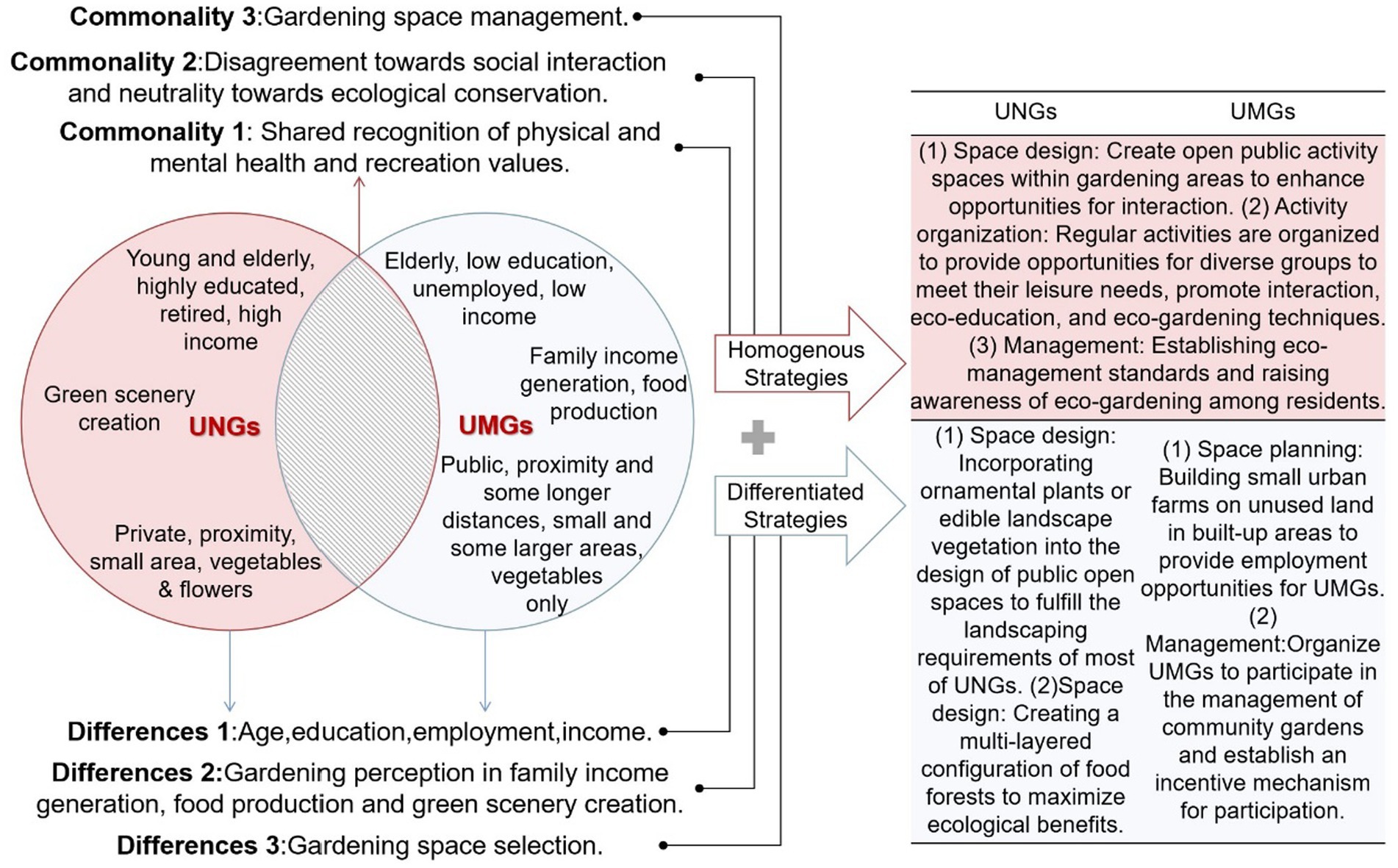
Figure 5. Urban gardening strategies based on the differences and similarities of the two groups of gardeners in China.
(2) Organization of activities: First, organizing regular gardening-related activities that cater to the diverse needs of gardeners across different age groups and, at the same time, provide opportunities for residents to interact with each other to realize the social interaction benefits of urban gardening. Such activities include nature education activities for children, sports and leisure activities for young gardeners, interactive planting activities for core family gardeners, and leisure and sports activities for older people. Secondly, in response to the lack of recognition of the ecological function of urban gardening, eco-gardening activities can also be planned to improve their ecological gardening skills through eco-education.
(3) Operation and management: In response to the more substantial food needs of UMGs, it is possible to organize migrant gardeners’ management groups and increase the possibility of obtaining material products for UMGs through the establishment of participation incentive mechanisms such as the “management time for vegetables: time-food exchange system.” In addition, as gardeners generally lack an understanding of the eco-values of urban gardening, it is possible to raise awareness of the eco-value through setting ecological management standards for the facilities and eco-friendly gardening practices.
5 Conclusion
This paper proposes a typology for classifying Chinese urban gardeners based on their urban–rural life experiences to develop a corresponding urban farming strategy amid China’s urbanization. Research reveals distinctions between Chinese UNGs and UMGs in motivations and behaviors. Recognizing shared needs for physical and mental health, leisure, and recreation, some UMGs also maintain a strong need for urban gardening to produce food and generate family income. Therefore, the study recommends a shift from the “one-size-fits-all” policy strategy of promoting community gardens and banning informal gardening to a more adaptable framework to address the needs of both types of gardeners, from space planning and design to the operation and management of the spaces and the organization of activities. Such a revised framework should also include the planning of small-scale urban farms, the creation of small public open spaces with ornamental plants to enhance the aesthetic appeal of urban gardening, and the establishment of an incentive mechanism to meet the diverse needs of urban gardeners and fully realize the value and benefits of urban gardening in promoting social cohesion and protecting the urban ecosystem.
Data availability statement
The raw data supporting the conclusions of this article will be made available by the authors, without undue reservation.
Author contributions
YX: Data curation, Writing – original draft. ZX: Funding acquisition, Supervision, Writing – review & editing.
Funding
The author(s) declare financial support was received for the research, authorship, and/or publication of this article. This study was financially supported by the National Natural Science Fund of China (No. 52178032) and was supported by Graduate Scientific Research and Innovation Foundation of Chongqing, China (No. CYB21036).
Conflict of interest
The authors declare that the research was conducted in the absence of any commercial or financial relationships that could be construed as a potential conflict of interest.
Publisher’s note
All claims expressed in this article are solely those of the authors and do not necessarily represent those of their affiliated organizations, or those of the publisher, the editors and the reviewers. Any product that may be evaluated in this article, or claim that may be made by its manufacturer, is not guaranteed or endorsed by the publisher.
Footnotes
1. ^“Individuals moved to cities from rural area” refers to individuals who previously resided in rural areas but now dwell in urban areas. This encompasses individuals living in cities with rural household registration and those whose household registration and current residence are in cities but were formerly located in rural areas. When they not only live in a city but have integrated seamlessly into its social welfare, public services, attitudes, lifestyles, and more, following the practices and lives of typical city dwellers, they are considered entirely urban residents.
2. ^The reservation area of the “Four Mountains” refer to the development, construction and its management activities control area, planning to protect the ecological and environmental resources of Jinyun Mountain, Zhongliang Mountain, Tongluo Mountain and Mingyue Mountain in main urban area.
3. ^In the Chinese context, the term “basic farmland” refers to those farms that are surrounded by cities because of rapid urbanization but must be protected under China’s farmland protection policy.
References
Adams, D., Hardman, M., and Larkham, P. (2014). Exploring guerrilla gardening: gauging public views on the grassroots activity. Local Environ. 20, 1231–1246. doi: 10.1080/13549839.2014.980227
Ainembabazi, J. H., and Mugisha, J. (2014). The role of farming experience on adopting agricultural technologies: evidence from smallholder farmers in Uganda. J. Dev. Stud. 50, 666–679. doi: 10.1080/00220388.2013.874556
Amani-Beni, M., Xie, G., Yang, Q., Russo, A., and Khalilnezhad, M. R. (2021). Socio-cultural appropriateness of the use of historic Persian gardens for modern urban edible gardens. Land 11:38. doi: 10.3390/land11010038
Armstrong, D. (2000). A survey of community gardens in upstate New York: implications for health promotion and community development. Health Place 6, 319–327. doi: 10.1016/s1353-8292(00)00013-7
Askerlund, P., and Almers, E. (2016). Forest gardens – new opportunities for urban children to understand and develop relationships with other organisms. Urban For. Urban Green. 20, 187–197. doi: 10.1016/j.ufug.2016.08.007
Beavers, A. W., Atkinson, A., Ma, W., and Alaimo, K. (2021). Garden characteristics and types of program involvement associated with sustained garden membership in an urban gardening support program. Urban For. Urban Green. 59:127026. doi: 10.1016/j.ufug.2021.127026
Bendt, P., Barthel, S., and Colding, J. (2013). Civic greening and environmental learning in public-access community gardens in Berlin. Landsc. Urban Plan. 109, 18–30. doi: 10.1016/j.landurbplan.2012.10.003
Bon, H., Parrot, L., and Moustier, P. (2010). Sustainable urban agriculture in developing countries. A review. Agron. Sustain. Dev. 30, 21–32. doi: 10.1051/agro:2008062
Booth, J. M., Chapman, D., Ohmer, M. L., and Wei, K. (2017). Examining the relationship between level of participation in community gardens and their multiple functions. J. Community Pract. 26, 5–22. doi: 10.1080/10705422.2017.1413024
Castro, D. C., Samuels, M., and Harman, A. E. (2013). Growing healthy kids: a community garden-based obesity prevention program. Am. J. Prev. Med. 44, S193–S199. doi: 10.1016/j.amepre.2012.11.024
Chan, K. W., and Buckingham, W. (2008). Is China abolishing the Hukou system? China Q. 195, 582–606. Available at: http://www.jstor.org/stable/20192236
Chen, Y., Li, X., Tian, Y., and Tan, M. (2009). Structural change of agricultural land use intensity and its regional disparity in China. J. Geogr. Sci. 19, 545–556. doi: 10.1007/s11442-009-0545-7
Chen, W., Wang, Q., Li, Q., Wang, Y., and Zheng, W. (2022). Exploring the impact of rural labor transfer on the production and ecological sustainability of crop planting structure in China. Environ. Sci. Pollut. Res. 30, 22668–22685. doi: 10.1007/s11356-022-23613-5
China Daily (2021). Master plan for economic circle unveiled. Available at: http://english.www.gov.cn/policies/policywatch/202110/22/content_WS6171fb03c6d0df57f98e3a78.html (Accessed November 20, 2023)
China National Bureau of Statistics (2020). The seventh national population census. Available at: http://www.stats.gov.cn/sj/tjgb/rkpcgb/qgrkpcgb/index_1.html (Accessed November 20, 2023).
Chongqing Municipal Bureau of Statistics (2022). Chongqing statistical yearbook. Available at: https://tjj.cq.gov.cn/zwgk_233/tjnj/tjnj.html?url=https://tjj.cq.gov.cn/zwgk_233/tjnj/2022/zk/indexch.htm (Accessed November 20, 2023).
Chongqing Urban Management Bureau (2023). Governance of the destruction of greenery and planting of vegetables. Available at: https://cgj.cq.gov.cn/cqs/searchResultPC.html?tenantId=84&configTenantId=84&areaCode=500000125&searchWord=%E8%8F%9C%E5%9C%B0 (Accessed November 20, 2023).
Clark, K. H., and Nicholas, K. A. (2013). Introducing urban food forestry: a multifunctional approach to increase food security and provide ecosystem services. Landsc. Ecol. 28, 1649–1669. doi: 10.1007/s10980-013-9903-z
Clarke, L. W., Jenerette, G. D., and Bain, D. J. (2015). Urban legacies and soil management affect the concentration and speciation of trace metals in Los Angeles community garden soils. Environ. Pollut. 197, 1–12. doi: 10.1016/j.envpol.2014.11.015
Department of Agriculture and Markets (2023). Farm-to-school. Available at: https://agriculture.ny.gov/farming/farm-school#:~:text=The%20New%20York%20State%20Farm-to-School%20Program%20was%20created,State%20schools%20through%20New%20York%20State%E2%80%99s%20Farm-to-School%20program (Accessed November 20, 2023).
Ding, X., Zhao, Z., Zheng, J., Yue, X., Jin, H., and Zhang, Y. (2022). Community gardens in China: spatial distribution, patterns, perceived benefits and barriers. Sustain. Cities Soc. 84:103991. doi: 10.1016/j.scs.2022.103991
Djokić, V., Ristić Trajković, J., Furundžić, D., Krstić, V., and Stojiljković, D. (2018). Urban garden as lived space: informal gardening practices and dwelling culture in socialist and post-socialist Belgrade. Urban For. Urban Green. 30, 247–259. doi: 10.1016/j.ufug.2017.05.014
Egerer, M., Lin, B. B., and Diekmann, L. (2020). Nature connection, experience and policy encourage and maintain adaptation to drought in urban agriculture. Environ. Res. Commun. 2:041004. doi: 10.1088/2515-7620/ab8917
Eigenbrod, C., and Gruda, N. (2014). Urban vegetable for food security in cities. A review. Agron. Sustain. Dev. 35, 483–498. doi: 10.1007/s13593-014-0273-y
Falkowski, T. B., Jorgensen, B., Rakow, D. A., Das, A., Diemont, S. A. W., Selfa, T., et al. (2022). “Connecting with good people and good plants”: community gardener experiences in New York state during the COVID-19 pandemic. Front. Sustain. Food Syst. 6:854374. doi: 10.3389/fsufs.2022.854374
Fisher, R. A. (1922). On the interpretation of χ2 from contingency tables, and the calculation of P. J. R. Stat. Soc. 85, 87–94. Available at: http://www.jstor.org/stable/2340521
Gaston, K. J., Warren, P. H., Thompson, K., and Smith, R. M. (2005). Urban domestic gardens (IV): the extent of the resource and its associated features. Biodivers. Conserv. 14, 3327–3349. doi: 10.1007/s10531-004-9513-9
Ge, Y., Kiminami, L., and Furuzawa, S. (2021). Perception and behavior of residents towards community gardens and satisfaction of local life: empirical analysis on the case of Shanghai, China. Asia-Pac. J. Reg. Sci. 6, 141–158. doi: 10.1007/s41685-021-00219-2
Golledge, R. G., Brown, L. A., and Williamson, F. (2007). Behavioural approaches in geography: an overview. Aust. Geogr. 12, 59–79. doi: 10.1080/00049187208702613
Golledge, R. G., and Timmermans, H. (1990). Applications of behavioural research on spatial problems I: cognition. Prog. Hum. Geogr. 14, 57–99. doi: 10.1177/030913259001400104
Górna, A., and Górny, K. (2020). Urban agriculture in Havana – evidence from empirical research. Misc. Geogr. 24, 85–93. doi: 10.2478/mgrsd-2020-0012
Hardman, M., Chipungu, L., Magidimisha, H., Larkham, P. J., Scott, A. J., and Armitage, R. P. (2018). Guerrilla gardening and green activism: rethinking the informal urban growing movement. Landsc. Urban Plan. 170, 6–14. doi: 10.1016/j.landurbplan.2017.08.015
He, B., and Zhu, J. (2018). Constructing community gardens? Residents’ attitude and behaviour towards edible landscapes in emerging urban communities of China. Urban For. Urban Green. 34, 154–165. doi: 10.1016/j.ufug.2018.06.015
Hemmelgarn, H. L., and Munsell, J. F. (2021). Exploring ‘beyond-food’ opportunities for biocultural conservation in urban forest gardens. Urban Agric. Region. Food Syst. 6:e20009. doi: 10.1002/uar2.20009
Jahrl, I., Moschitz, H., and Cavin, J. S. (2021). The role of food gardening in addressing urban sustainability – a new framework for analysing policy approaches. Land Use Policy 108:105564. doi: 10.1016/j.landusepol.2021.105564
Khalilnezhad, M. R., Russo, A., and Jannatifar, M. A. (2022). Forgotten edible heritage: the case study of the UNESCO site of Akbarieh garden in Iran. Arboric. J. 44, 234–247. doi: 10.1080/03071375.2022.2085942
Kirby, C. K., Specht, K., Fox-Kämper, R., Hawes, J. K., Cohen, N., Caputo, S., et al. (2021). Differences in motivations and social impacts across urban agriculture types: case studies in Europe and the US. Landsc. Urban Plan. 212:104110. doi: 10.1016/j.landurbplan.2021.104110
Kou, H., Zhang, S., Li, W., and Liu, Y. (2021). Participatory action research on the impact of community gardening in the context of the COVID-19 pandemic: investigating the seeding plan in Shanghai, China. Int. J. Environ. Res. Public Health 18:6243. doi: 10.3390/ijerph18126243
Kou, H., Zhang, S., and Liu, Y. (2019). Community-engaged research for the promotion of healthy urban environments: a case study of community garden initiative in Shanghai, China. Int. J. Environ. Res. Public Health 16:4145. doi: 10.3390/ijerph16214145
Kumar, B. M., Singh, A. K., and Dhyani, S. K. (2012). “South Asian agroforestry: traditions, transformations, and prospects” in Agroforestry – the future of global land use. eds. P. K. R. Nair and D. Garrity (Dordrecht: Springer Netherlands), 359–389.
Lafontaine-Messier, M., Gélinas, N., and Olivier, A. (2016). Profitability of food trees planted in urban public green areas. Urban For. Urban Green. 16, 197–207. doi: 10.1016/j.ufug.2016.02.013
Lee, J. H., and Matarrita-Cascante, D. (2019). The influence of emotional and conditional motivations on gardeners’ participation in community (allotment) gardens. Urban For. Urban Green. 42, 21–30. doi: 10.1016/j.ufug.2019.05.006
Lewis, O., Home, R., and Kizos, T. (2018). Digging for the roots of urban gardening behaviours. Urban For. Urban Green. 34, 105–113. doi: 10.1016/j.ufug.2018.06.012
Li, Y., Zhang, S., and Zhu, D. (2023). Co-creation of community micro-renewals: model analysis and case studies in Shanghai, China. Habitat Int. 142:102951. doi: 10.1016/j.habitatint.2023.102951
Liere, H., Egerer, M., Sanchez, C., Bichier, P., and Philpott, S. M. (2020). Social context influence on urban gardener perceptions of pests and management practices. Front. Sustain. Food Syst. 4:547877. doi: 10.3389/fsufs.2020.547877
Lin, B. B., Philpott, S. M., and Jha, S. (2015). The future of urban agriculture and biodiversity-ecosystem services: challenges and next steps. Basic Appl. Ecol. 16, 189–201. doi: 10.1016/j.baae.2015.01.005
Lindemann-Matthies, P., and Brieger, H. (2016). Does urban gardening increase aesthetic quality of urban areas? A case study from Germany. Urban For. Urban Green. 17, 33–41. doi: 10.1016/j.ufug.2016.03.010
Lindemann-Matthies, P., and Marty, T. (2013). Does ecological gardening increase species richness and aesthetic quality of a garden? Biol. Conserv. 159, 37–44. doi: 10.1016/j.biocon.2012.12.011
Lohr, V. I., and Pearson-Mims, C. H. (2005). Children's active and passive interactions with plants influence their attitudes and actions toward trees and gardening as adults. HortTechnology 15, 472–476. doi: 10.21273/horttech.15.3.0472
Lu, D. (2022). Cultivating vibrant gardens in urban communities: success factors of community gardens in Beijing and Shanghai. J. Undergraduate Ethnogr. 12, 106–125. doi: 10.15273/jue.v12i2.11413
Lu, S., Wu, F., Wang, Z., Cui, Y., Chen, C., and Wei, Y. (2021). Evaluation system and application of plants in healing landscape for the elderly. Urban For. Urban Green. 58:126969. doi: 10.1016/j.ufug.2020.126969
Macdonald, T., and Winklerprins, A. M. G. A. (2019). Searching for a better life: peri-urban migration in Western Para state, Brazil. Geogr. Rev. 104, 294–309. doi: 10.1111/j.1931-0846.2014.12027.x
Mackiewicz, B., Szczepanska, M., Kacprzak, E., and Fox-Kaemper, R. (2021). Between food growing and leisure: contemporary allotment gardeners in Western Germany and Poland. Erde 152, 33–50. doi: 10.12854/erde-2021-502
Mai, X., Xu, Y., and Liu, Y. (2023). Cultivating an alternative subjectivity beyond neoliberalism: community gardens in urban China. Ann. Am. Assoc. Geogr. 113, 1348–1364. doi: 10.1080/24694452.2023.2187337
Matsumoto, D. (2007). Culture, context, and behavior. J. Pers. 75, 1285–1320. doi: 10.1111/j.1467-6494.2007.00476.x
Menconi, M. E., Heland, L., and Grohmann, D. (2020). Learning from the gardeners of the oldest community garden in Seattle: resilience explained through ecosystem services analysis. Urban For. Urban Green. 56:126878. doi: 10.1016/j.ufug.2020.126878
Newell, J. P., Foster, A., Borgman, M., and Meerow, S. (2022). Ecosystem services of urban agriculture and prospects for scaling up production: a study of Detroit. Cities 125:103664. doi: 10.1016/j.cities.2022.103664
Pearsall, H., Gachuz, S., Rodriguez Sosa, M., Schmook, B., Wal, H., and Gracia, M. A. (2019). Urban community garden agrodiversity and cultural identity in Philadelphia, Pennsylvania, U.S. Geogr. Rev. 107, 476–495. doi: 10.1111/j.1931-0846.2016.12202.x
Pennsylvania Department of Agriculture (2023). Farm to school grant program. Available at: https://www.agriculture.pa.gov/Funding/Farmbill/Pages/Farm-to-School-Grant.aspx (Accessed November 20, 2023).
Petrovic, N., Simpson, T., Orlove, B., and Dowd-Uribe, B. (2019). Environmental and social dimensions of community gardens in East Harlem. Landsc. Urban Plan. 183, 36–49. doi: 10.1016/j.landurbplan.2018.10.009
Philpott, S. M., Egerer, M. H., Bichier, P., Cohen, H., Cohen, R., Liere, H., et al. (2020). Gardener demographics, experience, and motivations drive differences in plant species richness and composition in urban gardens. Ecol. Soc. 25:8. doi: 10.5751/es-11666-250408
Qiu, P. (2013). Awareness and understanding of "Citizenship of the Agricultural Transfer Population". Available at: http://theory.people.com.cn/n/2013/0313/c40537-20778267.html#:~:text=%E6%8D%A2%E5%8F%A5%E8%AF%9D%E8%AF%B4%EF%BC%8C%E5%86%9C%E4%B8%9A%E8%BD%AC,%E5%8F%97%E7%9A%84%E8%BF%87%E7%A8%8B%E5%92%8C%E7%BB%93%E6%9E%9C%E3%80%82 (Accessed November 20, 2023).
Ryan, C. (2021). Atlanta creates the nation’s largest free food forest with hopes of addressing food insecurity. Available at: https://edition.cnn.com/2021/02/22/us/atlanta-free-food-forest-trnd/index.html (Accessed November 20, 2023).
Sanyé-Mengual, E., Specht, K., Vávra, J., Artmann, M., Orsini, F., and Gianquinto, G. (2020). Ecosystem services of urban agriculture: perceptions of project leaders, stakeholders and the general public. Sustainability 12:10446. doi: 10.3390/su122410446
Schoen, V., Blythe, C., Caputo, S., Fox-Kämper, R., Specht, K., Fargue-Lelièvre, A., et al. (2021). “We have been part of the response”: the effects of COVID-19 on community and allotment gardens in the global north. Front. Sustain. Food Syst. 5:732641. doi: 10.3389/fsufs.2021.732641
Shanghai Urban Management and Law Enforcement Bureau (2023). Governance of deforestation and vegetable cultivation. Available at: https://cgzf.sh.gov.cn/websearch/index.html#search/query=%E7%A7%8D%E8%8F%9C (Accessed November 20, 2023).
Song, S., Lim, M. S., Richards, D. R., and Tan, H. T. W. (2022). Utilization of the food provisioning service of urban community gardens: current status, contributors and their social acceptance in Singapore. Sustain. Cities Soc. 76:103368. doi: 10.1016/j.scs.2021.103368
Speak, A. F., Mizgajski, A., and Borysiak, J. (2015). Allotment gardens and parks: provision of ecosystem services with an emphasis on biodiversity. Urban For. Urban Green. 14, 772–781. doi: 10.1016/j.ufug.2015.07.007
Statistical Bureau of the People's Republic of China (2021). China Statistical Yearbook. Available at: http://www.stats.gov.cn/sj/ndsj/2021/indexch.htm (Accessed November 20, 2023).
Suto, M. J., Smith, S., Damiano, N., and Channe, S. (2021). Participation in community gardening: sowing the seeds of well-being. Can. J. Occup. Ther. 88, 142–152. doi: 10.1177/0008417421994385
Teuber, S., Schmidt, K., Kühn, P., and Scholten, T. (2019). Engaging with urban green spaces – a comparison of urban and rural allotment gardens in southwestern Germany. Urban For. Urban Green. 43:126381. doi: 10.1016/j.ufug.2019.126381
Triandis, H. C. (1989). The self and social behavior in differing cultural contexts. Psychol. Rev. 96, 506–520. doi: 10.1037/0033-295X.96.3.506
Van Den Berg, A. E., and Custers, M. H. (2011). Gardening promotes neuroendocrine and affective restoration from stress. J. Health Psychol. 16, 3–11. doi: 10.1177/1359105310365577
Van den Berg, A. E., van Winsum-Westra, M., de Vries, S., and van Dillen, S. M. E. (2010). Allotment gardening and health: a comparative survey among allotment gardeners and their neighbors without an allotment. Environ. Health 9, 1–2. doi: 10.1186/1476-069x-9-74
Wei, Y., and Jones, P. (2022). Emergent urban agricultural practices and attitudes in the residential area in China. Urban For. Urban Green. 69:127491. doi: 10.1016/j.ufug.2022.127491
Wen, C. (2023). Shenzhen: the gateway to the "we garden", where even "small patches of land" hold "poetry and distant lands". Available at: https://mp.weixin.qq.com/s?__biz=MzIzOTcyNDEzMg==&mid=2247790688&idx=1&sn=6c574d1b5904c82c723e2971238deb89 (Accessed November 20, 2023).
Wu, C., Li, X., Tian, Y., Deng, Z., Yu, X., Wu, S., et al. (2022). Chinese residents’ perceived ecosystem services and disservices impacts behavioral intention for Urban Community garden: an extension of the theory of planned behavior. Agronomy 12:193. doi: 10.3390/agronomy12010193
Xinhua News Agency (2022). China's efforts to promote citizenship among the agricultural migrant population. Available at: https://www.gov.cn/xinwen/2022-03/17/content_5679597.htm (Accessed November 20, 2023).
Yuelai Liu, K. Y., Sun, Z., Hai, Y., and Mao, J. (2022). Cooperative landscape——a case study of the experiment of integrating public space renewal and social governance of community gardens in Shanghai. Architect. J. 3, 12–19. doi: 10.19819/j.cnki.ISSN0529-1399.202203002
Yufeng Wang, J. Z., and Wang, S. (2023). Discover the beauty of Chongqing, where vegetable plots are transformed into eco-friendly houses. Available at: https://wap.cqcb.com/shangyou_news/NewsDetail?classId=7821&newsId=5194605 (Accessed November 20, 2023).
Zhang, X., Pan, D., Wong, K., and Zhang, Y. (2022). A new top-down governance approach to community gardens: a case study of the “we garden” community experiment in Shenzhen, China. Urban Sci. 6:41. doi: 10.3390/urbansci6020041
Zhang, K. H., and Song, S. (2003). Rural–urban migration and urbanization in China: evidence from time-series and cross-section analyses. China Econ. Rev. 14, 386–400. doi: 10.1016/j.chieco.2003.09.018
Keywords: China, urban gardening policy, urban native gardeners, urban migrated gardeners, gardening motivation, gardening behavior
Citation: Xie Y and Xing Z (2024) Adapting to urban gardening in China: how will policymaking help migrant and native gardeners? Front. Sustain. Food Syst. 7:1287150. doi: 10.3389/fsufs.2023.1287150
Edited by:
Sreetheran Maruthaveeran, Putra Malaysia University, MalaysiaReviewed by:
Amy M. Lerner, University of California, San Diego, United StatesMohammad Reza Khalilnezhad, University of Birjand, Iran
Sarah Milliken, University of Greenwich, United Kingdom
Copyright © 2024 Xie and Xing. This is an open-access article distributed under the terms of the Creative Commons Attribution License (CC BY). The use, distribution or reproduction in other forums is permitted, provided the original author(s) and the copyright owner(s) are credited and that the original publication in this journal is cited, in accordance with accepted academic practice. No use, distribution or reproduction is permitted which does not comply with these terms.
*Correspondence: Yusi Xie, emily5225@126.com
 Yusi Xie
Yusi Xie Zhong Xing
Zhong Xing